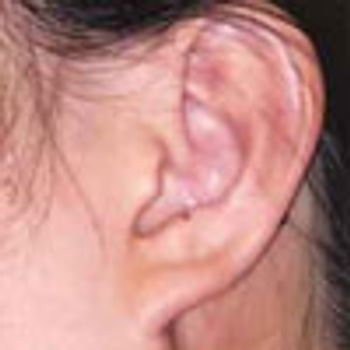
A 20-year-old woman presented with a painless left facial mass that had slowly enlarged over the previous 2 years. There was no facial numbness or weakness. Her medical history was unremarkable, and there was no recent weight loss.

A 20-year-old woman presented with a painless left facial mass that had slowly enlarged over the previous 2 years. There was no facial numbness or weakness. Her medical history was unremarkable, and there was no recent weight loss.

ABSTRACT: Only a small number of patients with celiac disease exhibit the textbook symptoms of malabsorptive diarrhea with steatorrhea, weight loss, and nutritional deficiencies. Others may present with a subclinical enteropathy, GI complaints without constitutional symptoms, persistent travelers' diarrhea, or extraintestinal manifestations alone. Be alert for suggestive signs, such as weight loss, skin lesions, oral aphthae, muscle atrophy, de-enamelization of the teeth, and vague GI symptoms, such as bloating. Helpful serologic tests include IgG and IgA antigliadin antibodies, enzyme tissue transglutaminase antibodies, antiendomysial antibodies, and total IgA. Typical endoscopic findings are mucosal atrophy, fissuring, and scalloping. In addition to a gluten-free diet, management encompasses repletion of vitamins and minerals, including iron, folate, calcium, and vitamin D; screening for thyroid disease and diabetes mellitus; bone densitometry and age-appropriate cancer screening; and pneumococcal vaccination.

In his recent editorial "Why We Need to Know the Limitations of Evidence-Based Medicine", Dr Gregory Rutecki questioned whether the findings of randomized controlled trials (RCTs) can be extrapolated to patients in primary care practices, who often have multiple comorbidities.

ABSTRACT: Only a small number of patients with celiac disease exhibit the textbook symptoms of malabsorptive diarrhea with steatorrhea, weight loss, and nutritional deficiencies. Others may present with a subclinical enteropathy, GI complaints without constitutional symptoms, persistent travelers' diarrhea, or extraintestinal manifestations alone. Be alert for suggestive signs, such as weight loss, skin lesions, oral aphthae, muscle atrophy, de-enamelization of the teeth, and vague GI symptoms, such as bloating. Helpful serologic tests include IgG and IgA antigliadin antibodies, enzyme tissue transglutaminase antibodies, antiendomysial antibodies, and total IgA. Typical endoscopic findings are mucosal atrophy, fissuring, and scalloping. In addition to a gluten-free diet, management encompasses repletion of vitamins and minerals, including iron, folate, calcium, and vitamin D; screening for thyroid disease and diabetes mellitus; bone densitometry and age-appropriate cancer screening; and pneumococcal vaccination.

A 20-year-old woman presented with a painless left facial mass that had slowly enlarged over the previous 2 years. There was no facial numbness or weakness. Her medical history was unremarkable, and there was no recent weight loss.

MADISON, Wis. -- Regular exercise three or more times a week reduced the risk of developing age-related macular degeneration by as much as 70%, researchers here reported.

SAN DIEGO, Calif. -- Strattera (atomoxetine) given to children with attention deficit hyperactivity disorder does not appear to stunt growth over the long term, according to a lengthy study.

LAS VEGAS -- A dozen patients have undergone safe and effective transoral stomach stapling, researchers reported here.

LAS VEGAS -- An implanted device approved for treating the chronic nausea and vomiting associated with gastroparesis may also be useful for relieving these idiopathic symptoms in patients with normal gastric emptying.

LAS VEGAS -- A diet heavy in carbohydrates might tip the scales in favor of a cascade of factors that lead to esophageal cancer, according to a study reported here.

MILAN, Italy -- Two major players in the Italian kitchen -- bread and pasta -- may increase the risk of renal cell carcinoma, according to a large study here.

SAN FRANCISCO -- Breast reconstruction surgery in extremely obese women is associated with a high rate of complications, reported researchers here.

An 89-year-old woman is seen for a rash on her back of 2 days' duration. Has Broca aphasia and dense right hemiparesis from an old stroke; remains highly communicative without words, and interactive, in the nursing home where she lives. Long-standing diabetes mellitus and hypertension contributed to the stroke and to marked peripheral arterial disease.

SEATTLE -- Surgery to correct obstructive sleep apnea (uvulopalatopharyngoplasty) is more likely to have complications if the condition is severe, a concurrent retrolingual procedure is done, BMI is high, or there are medical comorbidities, found a VA study.

NEW YORK -- Survivors of childhood cancer may face futures fraught with vastly greater chronic and life-threatening health risks than those of their siblings, according to a large retrospective study.

PROVIDENCE, R.I. -- A daily trip to the scale may help dieters maintain their weight loss over the long term, researchers said.

A 65-year-old man consults his primary care physician because of concern about nonpruritic yellowish lesions on his eyelids. He says they have been present for the past few years but have recently become more numerous.

ENDIBURGH, Scotland -- Fitness helps keep minds agile as time goes by, according to European studies.

PHILADELPHIA -- Psoriasis appears to be an independent risk factor for myocardial infarction, especially for younger patients with severe disease, researchers reported.

SAN ANTONIO -- Children with high blood pressure are more likely to snore and have other sleep disordered breathing problems than normotensive peers, researchers reported here.

NEW YORK -- A Mediterranean-style diet -- spare on red meat and heavy on fruits, vegetables, and olive oil -- may help to fend off Alzheimer's disease, reported researchers here.

NASHVILLE, Tenn. -- Weight, height, and race independently influence prostate-specific antigen (PSA) levels, and each may distort the risk of prostate cancer, researchers here reported.

GLASGOW, Scotland -- For overweight preschoolers, an extra dose of physical activity was not enough to shed the pounds, found researchers here.

BOSTON -- Quaffing Coke, Pepsi, and their carbonated cola cousins, including decaf and diet versions, is associated with lower bone mineral density in older women, researchers here reported.

BETHESDA, Md. -- Obesity and smoking, when combined, add up to as much as a fivefold increase in the risk of early all-cause mortality.